Hello everyone, today I am here to give an overview of Maratha Empire. It is considered as one of the great empire ever happened in the Indian history.
Why did the Mughal Army fail to destroy the Marathas?
Firstly, all the foreigners who came to India, they had to fight against the Rajputs of Rajasthan. Rajputs were one of the big problems in front of the Mughals. Likewise, legends like Maharana Pratap resisted Mughals in the reign of Akbar.
After, the first defeat of Chittorgarh, the Rajput shifted and took shelter at Udaipur, now known as the city of the lake as it is rounded by Satpuda range.
When Aurangzeb was on the throne of Delhi, he changed the policy of Akbar and started an open war. At that time, after Udaipur, some Rajput families shifted towards the Deccan Plateau. The Deccan Plateau gave the final fight with the heroic personality Chhatrapati Shivaji Maharaj.
Sedulous Maratha fought for the Motherland and the Mughals attacked them to satisfy their greedy intentions.
Also, after Shivaji Maharaj, Sambhaji Maharaj strengthened the Maratha army, but unfortunately he got captured in a Mughal trap. Then, after Sambhaji Maratha was nearly destroyed. Chhatrapati Rajaram, Maharani Tarabai still saved the existence of the Maratha Empire from evil.
There was no hope the Maratha empire would grow in the future. But brave Warrior Peshwa Balaji Vishwanath expanded the Maratha empire beyond current Indian boundaries. No one thought at that time, that the small Maratha Empire would grow so rapidly.
Introduction to Maratha Empire
The Maratha empire (also known as Mar~haatta), or the Maratha Federation, was a state in today’s India.
This Maratha Empire existed from 1647 to 1818, and during the peak of its glory, 250 million acres (1 million kilometers) of land in different empires/states, or, in other words, one-third of the Asian continent, belonged to this empire.
In line with the state’s tradition, the King ruled under the guidance of eight ministers.
When the British were trying to strengthen their rule in India, the Maratha empire proved to be a big threat to their regional ambitions. The Maratha empire is related to the Bhosale clan.
After fighting a series of battles with the British, the Marathas were finally defeated in 1818. Quite a few estates were born from the remains of this empire under the superiority of the British.
However, even today, the Maratha Empire is still alive in India in the state of Maharashtra, which was created in 1960, as a Marathi-speaking state.
For this reason, it was also known as the Marathi Empire. In spite of the diversity of religions and castes, the Indian way of life symbolizes various traditions, like social strength and unity among castes.
Maratha Empire after Smbhaji Maharaj
- After Sambhaji the Mughals attacked straight on Raigad as Raigad was so difficult to capture. One theory says that, Mughals made union with fort commander Suryaji Pisal.
- According to that theory, the Mughals knew Suryaji Pisal was greedy, so the Mughal commander offered Surdeshmukhi of Wai. In return, Suryaji handed over Raigad to Mughals and the royal family with Yesubai and her son Shahu were captured.
- As Chanakya said, “A traitor in colleagues is more dangerous than an enemy”, Suryaji is one of the traitors like Ganoji Shire as the execution of Sambhaji happened because of him.
- The execution of Sambhaji caught fire in the Maratha Kingdom, and they stood against the Mughals. The Mughals thought that after Sambhaji the Maratha Empire would vanish.
- But, his thoughts remain in his mind only and Chhatrapati Rajaram Maharaj had frittered away his sleep, but he died suddenly due to lung disease on 3 March 1700.
- With the reign of Rajaram, there was a big question of who became the next Chhatrapati as Shahu was in the capture of the Mughals.
- At that instant, Shahu’s Aunt stands against Mughals and made her elder son Shivaji-II as next Chhatrapati with Dhanaji Jadhav as his military commander. Shivaji-II was a child when he became king, so all decisions were taken by Tarabai. She fought for about 8 years with Mughals from 1700 to 1708 A.C.
- After the death of Aurangzeb, in the war of succession, throne of Delhi was captured by Azam Shah. He released Shahu with the advice of Zulphikar Khan, and Yesubai was kept as a prisoner for 10 more years in order to obey his order.
- Releasing Shahu started the war of Succession in the Maratha Empire. In the battle of Shivaji-II and Shahu, Shahu badly defeated Shivaji-II.
- As Shahu became the next Chhatrapati of Satara, Tarabai went to Kolhapur and established the second throne of the Maratha Empire. Kolhapur came to be known as Karveer Nagari. So finally, there were two thrones Satara and Kolhapur.
- There was not enough information available about Shivaji-II. His reign was also very short of 11 years.
- Shahu Maharaj plays the significant role after Sambhaji Maharaj as Rajaram and Shivaji had a short reign.
- He appointed eight ministers and Balaji Vishwanath as his Prime Minister, Peshwa (Chief Military Commander), Balaji started the campaign to release Yesubai.
- Balaji Vishwanath entered Delhi with 500 trustworthy cavalries and, with the help of Mughal kingmakers, they succeeded in releasing Yesubai.
- Releasing Yesubai Shahu started the direct war with Mughals, but was interrupted by the sudden death of Balaji due to a sudden fall in his health on 12th April 1720.
- Afterward, Shahu appointed Baji Rao-I as his Peshwa when he was only 20 years old. He was the elder son of Balaji Vishwanath.
- Though Baji Rao expanded the Maratha Kingdom into Maratha Empire, without proper leadership skills it’s not possible to execute operations in right way.
- Shahu Maharaj had excellent person discerning skills and had great influence on his colleagues, courtiers, and knights. Therefore, those people are very much loyal and humble to Shahmbhu Raje.
Founder of Maratha Empire
The history of Maratha Empire starts with the establishment of the Maratha Kingdom and obviously with the founder of the Maratha Empire, who is none other than “Chhatrapati Shivaji Maharaj.”
The founding of such an empire in an oppressive rule of foreign invaders was not easy. At that time, no one in India had the ability to even think of founding such an empire.
On the other hand, Chhatrapati Shivaji was not directly from any Royal family. His father was a general in the court of Adil Shah.
So, Chhatrapati Shivaji founded the Maratha Empire entirely on his own ability. No one can refuse this statement.
Even while standing off against the Muslim Mughal Empire for many years, the Maratha Empire abided by one of the basic beliefs of religious tolerance of its founder.
Necessity of Studying Maratha Empire
In the current era, which is often torn apart by religion and class, it is necessary to recite the saga of such a well-organized state, where every talented person could become successful and where people could worship their beliefs without experiencing torment or discrimination.
By studying this empire, one can restore a balanced history and learn how intolerant organizations and religious conflicts can be set aside and how people from different castes can communicate and live together.
Maratha Empire History
Chhatrapati Shivaji Maharaj fought battle with the help of Ganimi Kava war technique against the Nijam Shah, Adil Shah of Bijapur and Mughal King Aurangzeb.
The civilians, tired of exploitation by these invaders, turned to Chhatrapati Shivaji Maharaj and respected him like a God.
In this way, Chhatrapati Shivaji Maharaj got the independent state of Maratha in 1674, whose capital was Rajgad.
Shivaji Maharaj died in the year 1680, leaving behind a large but insecure state. The Mughals made unsuccessful attempts for 25 years between 1682 and 1707.
During the reign of the Mughals, due to some circumstances, Shahu Maharaj appointed Peshwa (prime minister) as the chief of state.
The grandson of Shivaji Maharaj, Shahu Maharaj, ruled till 1749. The title “Rajarshi” was bestowed upon him by the Kurmis of Kanpur.
After the death of Shahu Maharaj, Peshwa was the head of the state between 1749 and 1761, while the descendants of Shivaji Maharaj ruled the state from Satara.
A big part of the sub-continent was occupied by the Maratha Empire by keeping it away from the British monarchy, until the 18th century. After that, clashes started to happen between Peshwas and the king of Satara.
The Maratha Empire was at its pinnacle during the 18th century under the rule of Shahu Maharaj and the Peshwas.
After the defeat of Peshwas in the Third Battle of Panipat in the year 1761, the expansion of the Maratha Empire stopped, and the Peshwas started losing their power.
The Peshwas lost control of the state after their defeat in the Battle of Panipat in 1761.
A lot of commanders like Shinde, Holkar, Gaikwad, representatives, the Bhosale of Nagpur, the Pandits of Bhor, Patwardhan and Newalkar became the Kings of their regions.
This Empire made a free alliance in which the power of the state was divided among five Maratha clans, ‘Pancharatta’, namely, the Peshwas of Pune, Malwa and the Scindias (Shindhias) of Gwalior (originally called as Shinde), the Holkar of Indore, the Bhosale of Nagpur and the Gaikwad of Baroda.
In the beginning of the 19th century, the enmity between the Scindias and Holkars had an influence on the functioning of the alliance.
Similarly, three Anglo-Maratha wars that saw a tiff between the British and the British East India Company were also influential.
In 1818, in the third Anglo-Maratha, the last Bajirao Peshwa II was defeated by the British.
After that, a lot of the Maratha Empire was taken over by the British. However, a few Maratha states managed to remain half-independent till India got freedom from the British in 1947.
Chhatrapati Shivaji Maharaj
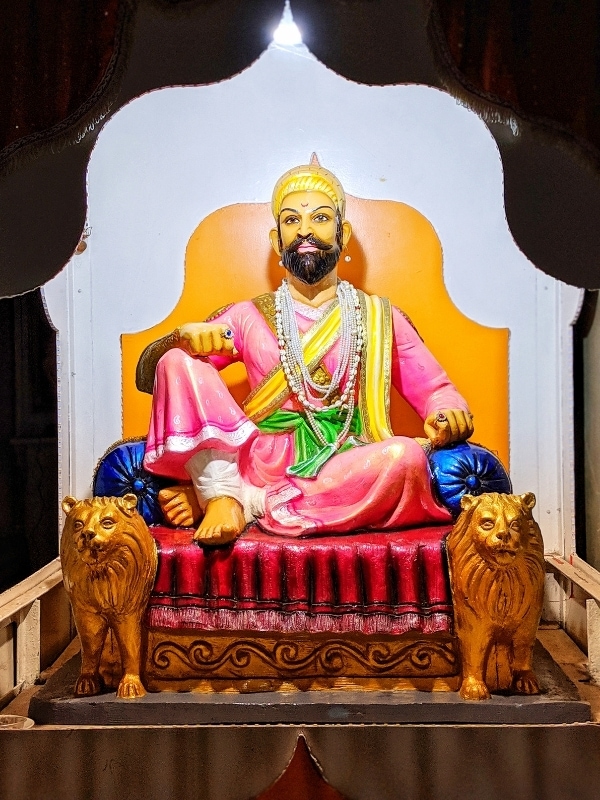
The Hindu Maratha settled down in Satara and the neighboring regions of the Deccan Plateau. It includes the region where a plateau meets the north-eastern mountains of the Sahyadri, Western Ghats, and its western region, popularly known as Konkan.
In this region, Shivray were successfully restricted the Muslim Mughal invasion, who were ruling the northern part of India at that time.
Under the leadership of Shivaji Maharaj, the Maratha made themselves independent from the Sultans of Bijapur in the north-east.
The Maratha got more aggressive and attacked more regions under the Mughal rule and even managed to take a Mughal port in Surat for ransom in 1664.
In 1674, Shivaji Maharaj accepted the title of ‘Chhatrapati’ as the emperor. He accurately used and developed the Ganimi warfare techniques and, with surprisingly speedy movements and precise attacks, completely demoralized the powerful enemy.
The Maratha had expanded and conquered a large part of central India by 1680. Unfortunately, Shivaji Maharaj died suddenly. After that, Chhatrapati Sambhaji Maharaj took responsibility of the Maratha empire.
According to Indian Historian Triyambak Shankar Shejwalkar, Shivaji Maharaj was inspired by the Vijayanagar Empire, which was a stronghold against the Muslim invasion in the south.
Shivaji Maharaj was also inspired by the then King of Mysore, King Kanthirao Narasraja Vodeyar, who defeated the emperor of Bijapur.
In opinion of Shivaji Maharaj, unity between God, country and religion was very important.
Chhatrapati Sambhaji Maharaj (Reign: 1681-1689)
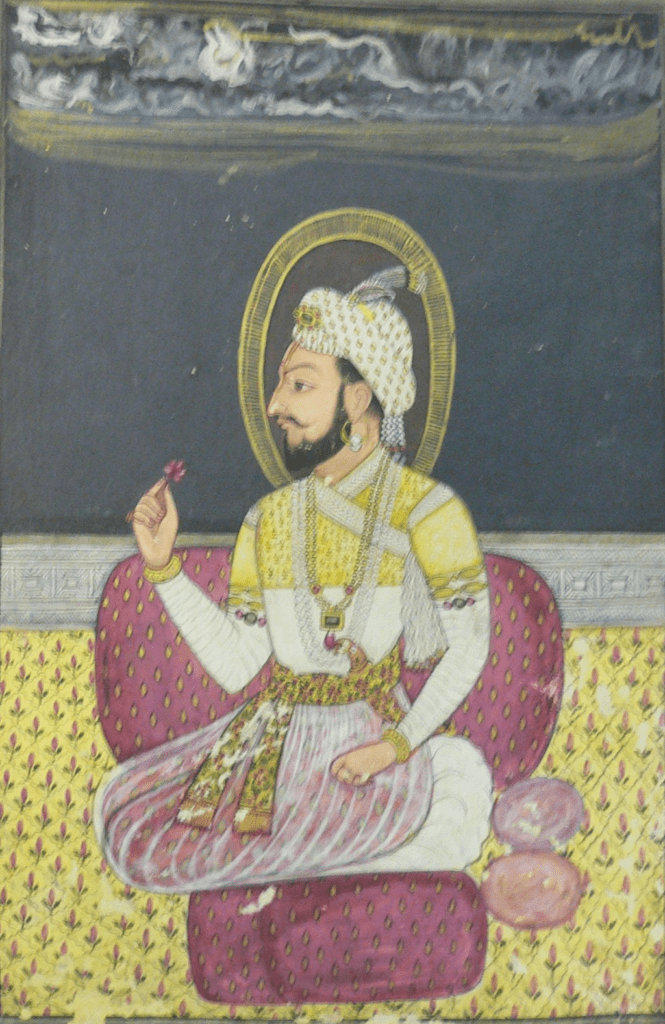
Shivaji Maharaj had two sons: Sambhaji and Rajaram. Sambhaji was his elder son, and was popular in many countries.
Along with being a clever politician and an outstanding warrior, he was also an excellent poet. He ascended the throne in 1681 and continued with his father’s policy of expansion.
Prior to this, he had defeated Chikka Dev Raya of Portugal and Mysore. In 1682, Aurangzeb himself made a march towards the South to end the Rajput-Maratha alliance and the Deccan Sultanate.
Taking the entire royal court, administration and around 4,00,000 soldiers along, Aurangzeb planned to defeat the Sultanate of Bijapur and Golconda.
Chhatrapati Sambhaji did not let Aurangzeb win even a single battle or invade any fort under his leadership for the next eight years. He definitely defeated Aurangzeb.
However, in 1689, relatives of King Sambhaji betrayed him and, with their help, Aurangzeb executed him. Aurangzeb was successful in defeating them.
A large scale drought happened in 1687-1688 in Maharashtra state. The situation was very difficult.
Rajaram Maharaj (reign: 1689-1700)
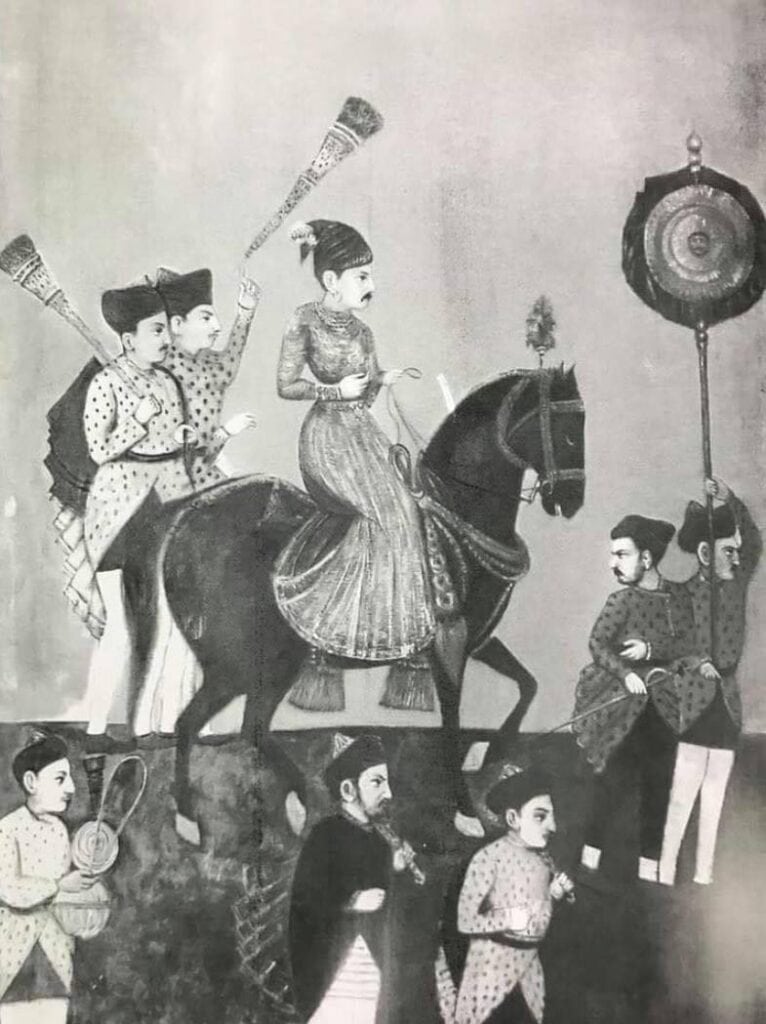
Rajaram, brother of Sambhaji, took the throne after Sambhaji. Chhatrapati Rajaram Maharaj and his faithful commander, Narveer Pilaji Gole, killed Kaakar Khan on the banks of the river Koyna.
Rajaram was at Pratapgad from June 10 – August 1689. Satara, which was made the capital by Rajaram, was captured and ultimately handed over to the Mughals. At the same time, Rajaram, who had taken refuge in Jinji, passed away.
Maharani Tarabai (Reign: 1689-1707)
The sudden death of Chhatrapati Rajaram drew his widow, Maharani Tarabai, into the battlefield. She ruled for around eight years and played as in—charge of the ruler and her son, who was named Shivaji-II.
Her demand for a war was refused. Till 1705, Tarabai led the Maratha Empire and protected the Maratha Empire against the Mughals with great bravery. She entered Mughal territory by crossing the Narmada River at Malwa.
The war of Malwa was a critical one for the Maratha Empire. After this war, the Mughals lost their ever-leading position in the Indian sub-continent and the Mughal emperors that followed the war were only namesake emperors.
The Maratha won the long-lasting battle of Nikra. The expansion of the Maratha Empire was mainly possible due to the immense contribution of their army and commanders. This victory laid the foundation for future grand victories.
Chhatrapati Shahu Maharaj (Reign: 1707-1749)
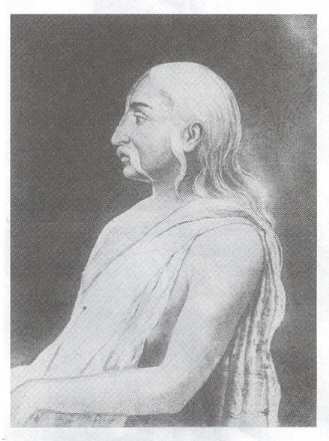
In 1707, after the death of emperor Aurangzeb, Shahuji, the son of Sambhaji (and the grandson of Shivaji), was rescued from the clutches of the next emperor, Bahadur Shah.
Immediately after being rescued, Shahuji ascended the throne and challenged his aunt, Rani Tarabai and her son. This led to a third party intervention in the Mughal-Maratha war.
The persistent dispute over the throne of the Maratha empire led to the formation of the states of Satara and Kolhapur in 1707. In the Treaty of Warna, signed in 1731, the existence of two independent states was confirmed.
In 1713, Farrukh Siyar declared himself as the Mughal emperor. His demand of a state was mainly dependent on his two brothers, known to everyone as the Sayyeds.
One of the Sayyeds was the governor of Allahabad, and the other was the governor of Patna. However, both the brothers had separated themselves from the emperor.
Due to the negotiations between Sayyeds and Peshwa Balaji Vishwanath, civil representatives of Shahu, the Maratha revolted against the emperor.
Under the leadership of Parsoji Bhosale, the Maratha army and the Mughal army marched towards Delhi without any opposition and successfully dethroned the emperor.
In return for this favor, Balaji Vishwanath asked for a treaty that included a lot of demands. Shahu had to accept the Mughal rule over Deccan and also had to pay an annual ransom money and give a part of his army in order to create a grand army.
In return, he got a claim on the entire Gujarat, Malwa and six current regions in Deccan which were under the Mughal rule. He also got a surety of the independent rule of the Maratha, and along with that, he and Sardeshmukh got a total of 35% of the total tax.
Due to this treaty, mother of Shahuji, Yesubai was also freed from the clutches of the Mughals.
Amatya Ramchandra Pant Bavdekar (1650-1716)
Ramchandra Pant Amatya Bavdekar was a judicial administrator who was brought up by a local family (Kulkarni) whose job was to keep local records.
Later on, under the guidance of Shivaji Maharaj, he was appointed as a member of the ‘Ashta Pradhan’ (eight ministers) whose job was to advise the King.
He was the chief Peshwa during the reign of Chhatrapati Shivaji, before the rise of the future Peshwas, and was the one to take control of Shahuji’s empire.
With his capability and dedication, he played an important role in protecting the Maratha Empire during its tough time.
In 1689, when Chhatrapati Rajaram had taken refuge in Jinji, he announced a “Hukumat Panha” (King-like status) in favor of Ramchandra Pant.
Ramchandra Pant had to face a lot of challenges, such as betrayals from the local officers, inadequate food supply and the inflow of dependents from outside the empire, and in spite of all these, he managed the entire Maratha empire.
He received help from the army of the brave Maratha warriors Santaji Ghorpade and Dhanaji Jadhav. There were many instances when he himself fought against the Mughals unanimously, in the absence of Chhatrapati Rajaram.
In 1698, when Rajaram offered the title staus of “Hukumat Panha” to his wife Tarabai, Ramchandra Pant relinquished this title.
Tarabai awarded him the post of Senior Administrator. He wrote a mandate in which he detailed the various mechanisms of war and supervision of forts.
Due to Ramchandra Pant’s devotion towards Tarabai (who was helped by local officers), he was dismissed in 1707, the year when Shahuji arrived.
In 1719, Balaji Vishwanath was awarded the post of Peshwa of the kingdom. In 1716, Balaji Pant died on the Panhala fort.
Maratha Empire at Its Peak
The Maratha Empire started their Golden Age after the release of Shahu Maharaj. Shahu Maharaj claimed the Satara throne and started to expand his kingdom.
At the same time, he got the priceless gem as his general, named Bajirao Ballal Bhat. He entered his military career far more earlier at the age of 16.
Peshwa Bajirao
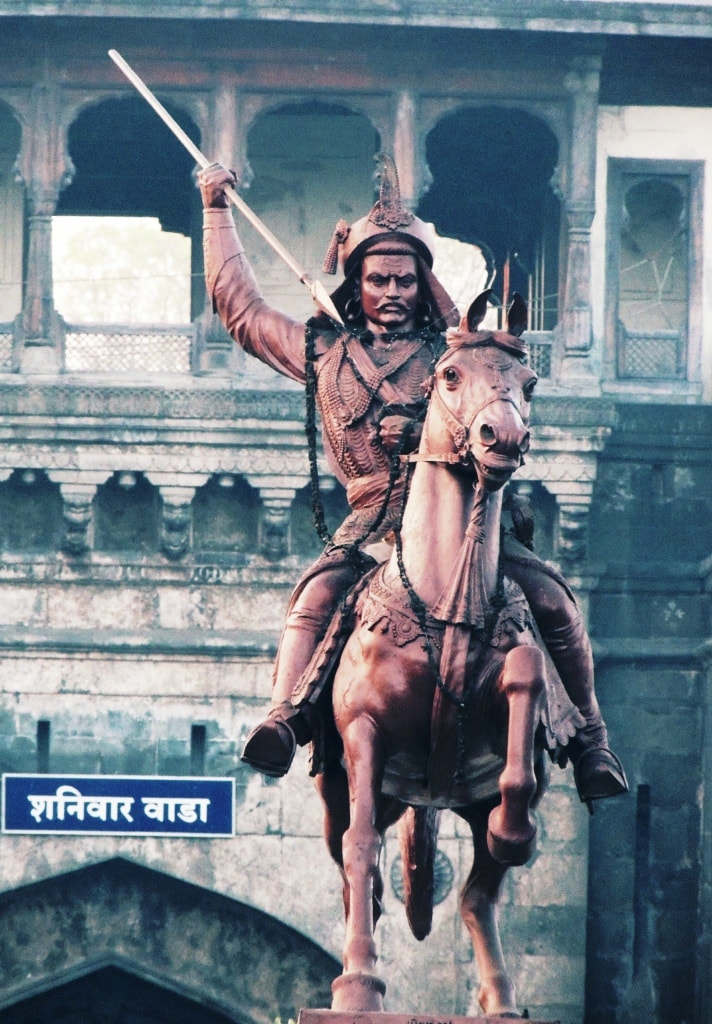
In April 1719, after the death of Balaji Vishwanath, Shahuji appointed Bajirao I as the Peshwa, and Bajirao I happened to be of a very mild nature.
Shahuji had a great ability to identify skills in other people. Therefore, he brought a lot of capable people to power, regardless of their social status.
This created a social revolution which was a symbol of incredible social integration. It already existed in the Maratha Empire. As a result, Maratha Empire developed very fast.
Shrimant Peshwa Bajirao Balaji Bhat who was also recognized as “Bajirao-I”, was the Peshwa during the reign of the fourth Maratha Chhatrapati Shahu Maharaj.
Bajirao Ballal became a Peshwa (Chief General) of the Maratha Empire after the death of his father, Balaji Vishwanath. Peshwa Bajirao officially reigned between April 17, 1720, and April 28, 1740.
He was also known as Bajirao Senior. Just like his father, he led the army in spite of being a Brahmin. He did not lose a single war in his life.
He is given the credit for expanding and taking the Maratha Empire to the greatest heights under his leadership. This is the reason for him being considered as the most popular Peshwa among all the nine Peshwas.
At a very young age, Bajirao was capable of understanding the scope of the expansion of the Maratha Empire in northern India.
Shrimant Peshwa Balajirao Bhat/ Shrimant Nana Saheb Peshwa (1740-1761)
The son of Bajirao, Balaji Bajirao (Nana Saheb), was chosen as the Peshwa by Shahu. The period between 1741 and 1745 was definitely a peaceful period in the Deccan compared to the earlier period. Shahuji passed away in 1749.
Nana Saheb encouraged farming, offered security to the villages and brought about significant development in the state. The further expansion was brought about by Raghunath Rao, the brother of Nana Saheb.
In 1756, after Ahmad Shah Durrani plundered Delhi and after Afghanistan’s withdrawal, Punjab was pressurized. Along with Delhi, the Maratha held power in Lahore as well.
Till 1760, after the defeat of the Nizam of Hyderabad in Deccan, the Maratha Empire had reached its largest limit of 250 million kilometers, equivalent to one-third of the area of the Indian sub-continent.
The Downfall of the Maratha Empire
The Peshwas challenged the Indian Muslim alliance under the leadership of the Afghan by sending an army that comprised Rohillas, Shujah-Ud-Daula, Nujeeb-Ud-Daula.
However, on January 14, 1761, in the Third Battle of Panipat, the Marathas were defeated decisively.
Suraj Maal and the Rajputs broke off the alliance at a very critical moment and abandoned the Marathas during a big battle.
The Marathas had to survive three continuous days without food because of a complete shut-down of all their routes. They became totally helpless in this situation and attacked the Afghans.
The defeat in the Battle of Panipat hindered the expansion of the Maratha Empire and ultimately the empire was divided.
After the battle, the Maratha federation never came together for any further battles.
Mahadji Shinde ruled Delhi/Gwalior; the Holkar of Indore ruled central India and the Gaikwad of Baroda controlled western India.
Even today, the meaning of the Marathi sentence “Meet your Panipat” and that of the English sentence “Met our Waterloo” are the same.
After 1761, the young Mahadeorao Peshwa, in spite of his frail health, tried to reconstruct the Maratha Empire.
In an attempt to manage a big empire effectively, half-autonomy was given to the bravest.
Due to this, the independent state of the Gaikwad of Baroda, the Holkar of Indore and [Malwa, Sindhiya of Gwalior (or Shinde) (and Ujjain), the Pawar of Udgir and the Bhosale of Nagpur (who had no relation with Shivaji Maharaj or family of Tarabai), all of these came into existence in the faraway lands.
Even in Maharashtra, many chiefs were given the charge of small states that had half-autonomy, because of which, Sangli, Aundh, Miraj and other states came into existence.
In 1775, the East India Company, whose base was in Mumbai, interfered in the fight for inheritance on behalf of Raghunathrao (also known as Raghoba Dada), and this led to the first Anglo-Maratha war.
This war ended in 1782, and the pre-war situation was restored.
In 1802, the British interfered in the decision to ascend the throne in Baroda against the ones who opposed the heirs, and they signed an agreement with the new King by promising him the highest position.
In the second Anglo-Maratha war (1803-1805), Peshwa Bajirao 2 also signed a similar agreement.
The third Anglo-Maratha war (1717-1718) was the last attempt to get back sovereignty. However, the Marathas ended up losing their independence, and, as a result, the British now rule over the most of India.
The Peshwas were deported to Bithur (Kanpur, U.P.) as the retirees of the British.
Some regions, including Kolhapur and Satara remained under the local rule. All the other areas under the Maratha rule, including Pune, came under British rule.
Gwalior, Indore and Nagpur, which were ruled by the Maratha Empire, tried to maintain their sovereignty by making some petty alliances with the British rule.
The other small states that belonged to the Maratha chiefs were also saved under British rule.
The last Peshwa, Nana Saheb, who was born as Govind Dhondu Pant, was adopted by Peshwa Bajirao 2.
He was the chief in the 1857 war against British rule. He motivated the Indian public and youth to fight against the British.
Tatya Tope, his commander, led the war and created panic in the minds of the British. Rani Laxmibai was his childhood friend and had a fraternal relationship with him.
Both of them fought against the British and also motivated the Indian army to fight against the British. Though they were defeated in this war, they are recognized as great patriots in Indian history.
The defeat in the third war came across as a stain on the glorious work that they did.
The spirit of the Maratha empire is nurtured even today in the state of Maharashtra, “Mahaan-Raashtra” which was established in 1960 as a Marathi-Language state.
In order to make Gujarat, Baroda and Kutch were brought together. Gwalior and Indore were integrated into Madhya Pradesh and Jhansi was integrated into Uttar Pradesh.
In Old Delhi, one can still find evidence of Maratha rule through the existence of the Nutan (New) Marathi School and Maharashtra Bhavan.
The Inheritance of the Empire
Often considered as a loose military establishment, the Maratha Empire was, in reality, quite revolutionary.
This Empire brought about a lot of revolutionary changes due to the exceptional wisdom of its most popular King, Shivaji Maharaj. These changes are listed below.
Right since its inception, Shivaji Maharaj always considered religious tolerance and religious plurality as the basic beliefs, and they were considered to be the pillars of nation-states.
The Maratha Empire was the only empire that did not believe in castes.
The Empire had Brahmins (Purohit class) as the prime ministers of the Kshatriya emperor (warrior class). Also, the Holkar who were Kshatriya Dhangar (shepherd) who were the chief trustees of the Brahmin Peshwas.
Since a lot of influential people were given the positions of leadership right since the beginning, this empire turned out to be the most progressive one.
It is worth noting that the ruler of Indore was a Dhangar (shepherd), rulers of Gwalior and Baroda were farmers, Peshwas from the Bhatt family belonged to a very ordinary family. Moreover, most trusted secretary of Shivaji Maharaj named Haider Ali Kohari also came from an ordinary household.
All the groups of the Maharashtrian society, like the Vaishyas (traders), Bhandari, Brahmins, Koli, Dhangar, Marathas and Saraswats had decent representation in the Maratha Empire.
The peculiarity of this empire was to keep aside the issues of castes and religion and give equal opportunities to everybody. The Marathas controlled the army squads in a big way.
Their policy of regional tolerance gave a lot of importance to the well-being of Hindus and curbed the expansion of the Mughal empire.
Our motherland, time to time, has given birth to brave freedom fighters. Those revolutionaries rebel against the oppressive rule.
The divided India of today is largely a part of the Maratha Federation. This empire also created a remarkable navy. The more important thing being, it was led by Kanhoji Angre.
Featured Image Credits: Rajaram Nadkarnia
